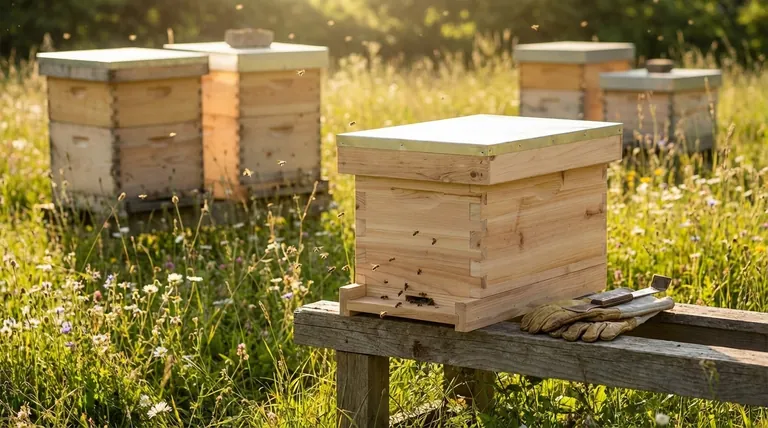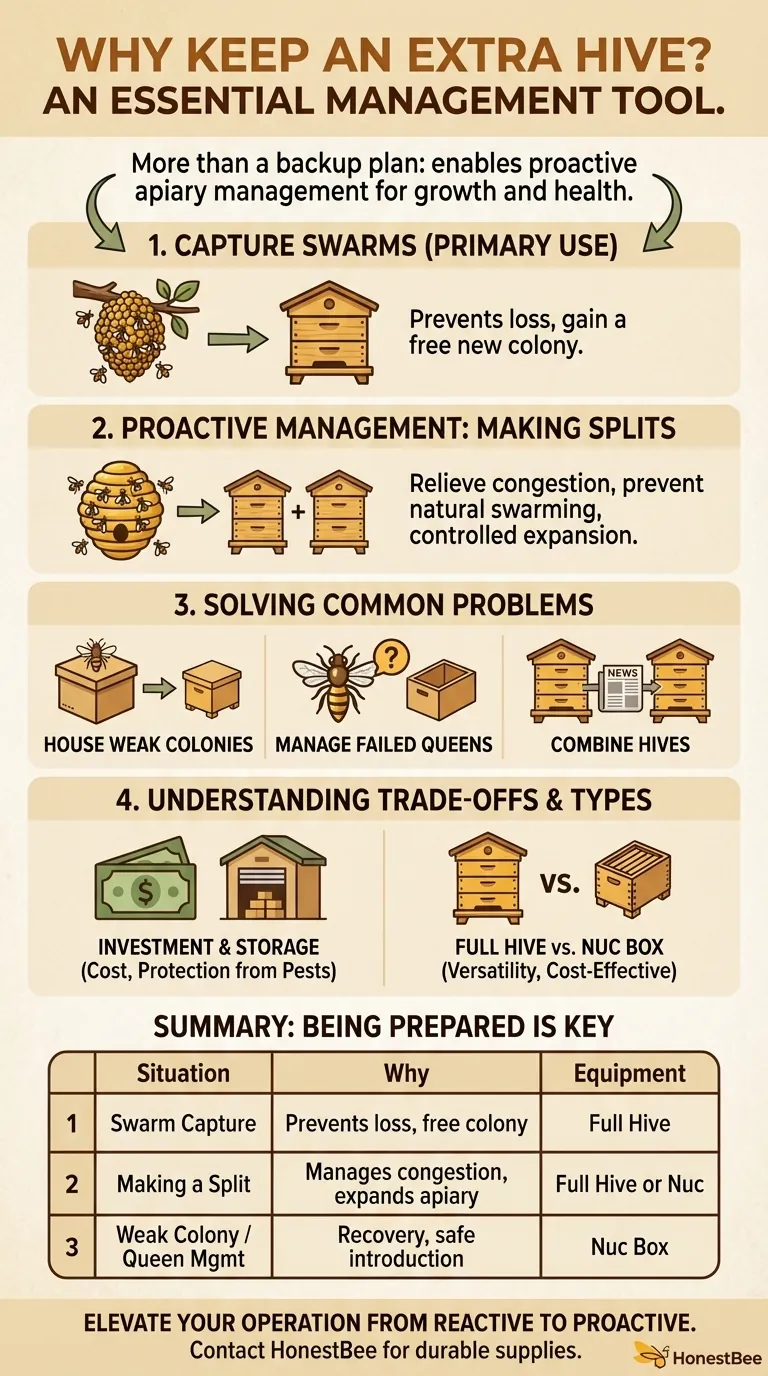Ultimately, an extra hive is an essential management tool. The most common and urgent reason to have one is to capture a swarm from one of your existing colonies, but its usefulness extends far beyond that single event. Having spare equipment on hand allows you to proactively manage your bees, solve common problems, and turn potential colony losses into opportunities for growth.
An extra hive isn't just a backup plan for emergencies like swarming; it is the fundamental equipment that enables you to transition from simply keeping bees to actively managing a healthy, productive apiary.

The Primary Use: Capturing Swarms
What is a Swarm?
A swarm is the natural way a honey bee colony reproduces. The old queen leaves the hive with about half of the worker bees to find a new home.
Why an Extra Hive is Essential
When a swarm issues, the bees will temporarily cluster on a nearby branch or structure while scout bees search for a suitable cavity.
If you have an empty hive ready, you can often capture this cluster and house them. This not only prevents the loss of half your bees but also effectively gives you a new, free colony.
Proactive Management: Making Splits
Preventing Swarms Before They Happen
The best way to manage swarming is to prevent it. A "split" is the beekeeper's method of creating an artificial swarm to relieve the congestion that triggers the natural swarm impulse.
How a Split Works
You move frames of eggs, larvae, pupae, and honey from the strong, populous colony into the empty hive. You can either move the old queen to the new hive or let the newly queenless half raise a new one from the eggs you provided.
The Benefits of Splitting
Splitting a hive dramatically reduces its urge to swarm. It also allows you to increase the number of colonies in your apiary under your own controlled conditions.
Solving Other Common Apiary Problems
Housing a Weak Colony
A struggling colony in a large hive can have trouble defending its space from pests or robbers. Moving them into a smaller hive, such as a 5-frame nucleus box, gives them a smaller, more defensible space to recover.
Dealing with a Failed Queen
If a queen fails or you need to requeen a hive, having a spare nucleus box is invaluable. It can be used to temporarily house a new queen before introduction or to raise a new queen from a frame of eggs.
Combining Hives
While combining doesn't require a full extra hive, it does require spare boxes. If one colony becomes hopelessly weak, you can combine it with a stronger one using a spare hive body and the newspaper method.
Understanding the Trade-offs
The Cost of Equipment
A complete hive setup represents a financial investment. The cost can be a barrier for new beekeepers who are already purchasing their primary equipment.
Storage and Maintenance
Spare woodenware needs to be stored in a dry, safe location. It must be protected from the elements and pests like wax moths, which can quickly destroy drawn comb.
What "Extra Hive" Really Means
An "extra hive" does not always mean a full-sized, 10-frame Langstroth hive. For many management tasks, a smaller 5-frame nucleus ("nuc") box is more versatile, less expensive, and easier to handle.
What Kind of Extra Hive Do You Need?
A little preparation transforms beekeeping challenges into manageable tasks. Having the right spare equipment on hand is the difference between reacting to a problem and controlling the situation.
- If your primary focus is swarm catching and expansion: A complete 8- or 10-frame hive (bottom board, boxes, frames, covers) is your best investment.
- If your primary focus is flexibility and queen management: A 5-frame nucleus box is an essential, cost-effective tool you will use constantly.
- If you are on a tight budget: Begin by acquiring at least a spare hive body and frames. You can build out the rest of the components as your budget allows.
Ultimately, being prepared is the cornerstone of successful and enjoyable beekeeping.
Summary Table:
| Situation | Why an Extra Hive is Essential | Recommended Equipment |
|---|---|---|
| Swarm Capture | Prevents loss of bees; provides a free, new colony. | Full 8- or 10-frame hive setup. |
| Making a Split | Manages colony congestion; prevents swarming; expands your apiary. | Full hive setup or 5-frame nucleus box. |
| Housing a Weak Colony | Provides a smaller, defensible space for a struggling hive to recover. | 5-frame nucleus box. |
| Queen Management | Essential for safely introducing a new queen or raising a new one. | 5-frame nucleus box. |
Ready to elevate your beekeeping operation from reactive to proactive?
An extra hive is a fundamental tool for commercial apiaries and distributors aiming for maximum productivity and colony health. HONESTBEE supplies the durable, high-quality beekeeping supplies and equipment you need to manage your apiary effectively.
Let us help you build a more resilient and profitable operation. Contact our wholesale experts today to discuss your equipment needs and get a quote!
Visual Guide

Related Products
- 5 Frame Wooden Nuc Box for Beekeeping
- Twin Queen Styrofoam Honey Bee Nucs Mating and Breeding Box
- Automatic Heat Preservation 6 Frame Pro Nuc Box for Honey Bee Queen Mating
- HONESTBEE Professional Long Handled Hive Tool with Precision Cutting Blade
- Portable Bee Mating Hive Boxes Mini Mating Nucs 8 Frames for Queen Rearing
People Also Ask
- How should the nuc be installed in the apiary? Ensure Colony Success from Day One
- How many frames does a typical wooden nuc box hold? A Guide to Choosing the Right Size
- What are the benefits of moving nuclei around the apiary? Master Strategic Hive Management
- What is the most common type of standard nuc? The 5-Frame Nuc Explained
- What frames should be moved into the queenless hive when requeening with a nuc? Ensure a Successful Queen Introduction



















